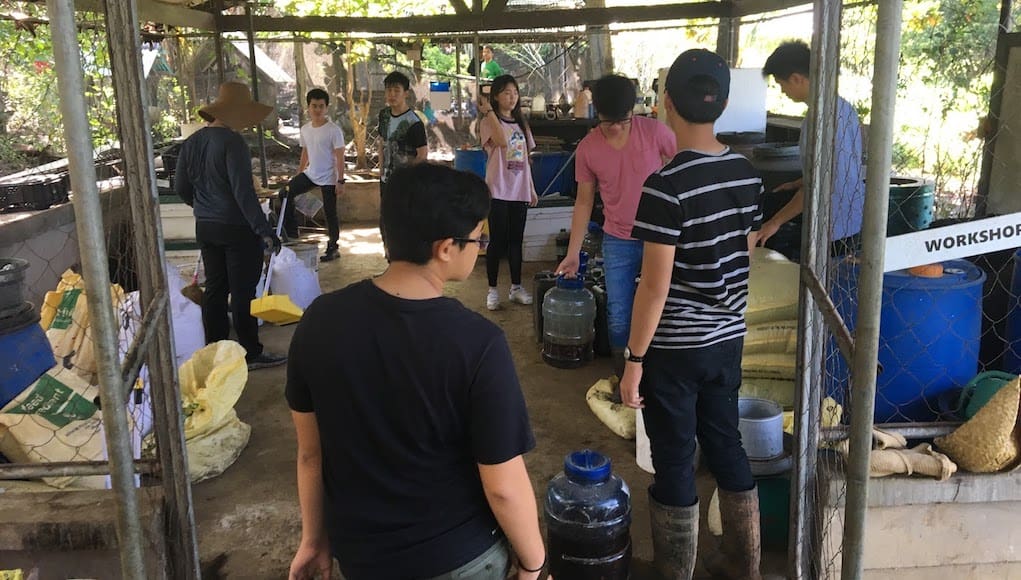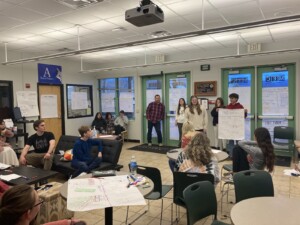Want Authentic PBL? Take Students to the Farm

At about 7:43 in the morning the pig keeled over and died. Five students exchanged looks, dumbfounded. Was it the feed? They were careful about concocting just the right mixture of feeder and natural compost. It was the same feed they had used since the beginning of their tenure of oversight.

Perhaps it was an unavoidable sickness. This summer had been hot and humid, increasing the risk for air-borne illness and bacterial infections.
The two grade 12 students who guided me on the tour of the farm seemed unaffected. Nonchalantly they mentioned to the younger students that they would need to “dispose of the pig before it contaminated the others.”
Nonetheless, the dead pig did signal a significant loss to the students’ pork business. Recently, outside investors provided the seed money for the animals in hopes that they would provide significant returns in the nearby meat market.
Authentic PBL and the Farm
You don’t get more “real world” than a dead pig on a farm.
This was not a hypothetical project, dreamed up in a classroom far removed from the outside world. It was a real project with real problems, consequences, dilemmas and opportunities for growth.
The farm represented the embodiment of Maria Montessori’s vision nearly 100 years prior. Students would operate and manage a farm entirely on their own. This would provide “valorization” for the adolescent by giving them a sense of purpose and meaning.

It would also help them learn economic independence.
After all, the farm represented a real business, that when operating at full capacity, created enough revenue to sustain it for years to come.
The Four “C’s”
There is a craze in today’s educational world about the 4 “C’s.” Teachers are attempting frantically to teach and assess these skills. There are maker spaces being thrown up in corners of schools; one off STEM experiences that allow students to work in teams; robotics competitions organized around a single challenge.
And while these experiences certainly have their place, they don’t offer the same experience as that of a farm.
A farm integrates the four “C’s” naturally. To make a farm work successfully, communication, collaboration, critical thinking and creativity are as natural as dealing with a dead pig.
Below, you will find a summary of what I witnessed in less than 30 minutes on a farm.
And while you may not have a “farm,” I encourage you as you read to think about what kind of deep learning experience you can provide students that utilize similar learner experiences to provide the same outcomes.
Enjoy.
Collaboration
On the farm, students are organized into a series of teams. Some teams are responsible for the maintenance and cleanliness of the farm, others responsible for feeding the animals, some for the growing and oversight of the garden, and a few for overall oversight of the farm. They all work together on one common goal: Make the farm economically viable.
Jobs on the farm are circulated on a yearly basis. The younger adolescents start with maintenance and gradually move up to management of plants and animals. Older students serve as mentors; ensuring the younger students develop the discipline and responsibility necessary for more advanced tasks.
As is the case with any Montessori community, it was hard to find a teacher. The students ran the project entirely on their own.

When I did finally find a teacher, they were meeting with one student; more likely than not, posing key inquiries to help push their thinking and leadership skills.
There were no rubrics or whiteboards on the farm, but there was a common understanding of the tasks that needed to be fulfilled. If a problem did arise, there was a debrief and a chance for students to solve the problem together.
Think about how you might foster collaboration in your classroom. What activities are natural in the running of your classroom/ school? Engage students in these activities and have them determine their roles. Finally, make sure to reflect on a regular basis to ensure growth.
Communication

I took this photo after my tour was complete. I was absolutely shocked by the amount of knowledge these students were able to disseminate. Beyond knowing the names and classifications of each plant, they were able to communicate the specific growing cycles and amount of sunlight/ water each plant needed to thrive. They explained that they chose the plants based on two factors; first, was its ability to flourish on the farm; second, was the nourishment it provided the animals. Students chose the animals based off their economic viability.
These particular students were only tour guides for the day. When new visitors arrived to the farm, a fresh batch of students would provide the overview.
As you can see from the picture, students didn’t need a high tech projection systems, flashing lights and curtains. They needed nothing more than an old phone and a place to jot down notes.
How might you foster greater communication amongst your students? Have you provided them with an authentic audience?
Students are dying to share what they know. We just need to provide them with the platform. After engaging students in deep, meaningful work, it is up to us to find an authentic audience with whom they can share their knowledge. This adds an extra level of integrity to their work, and provides a context for their acquisition of new knowledge and skills.
Finally, we should be providing them with several opportunities for practice and feedback to ensure they are polished for the real audience.
Creativity
Creativity occurred naturally on the farm. Pictured here is a solar panel that was added a week prior in order to power the aquaponic pumps. Students informed me that the sunlight captured in this single solar panel was enough to power the pumps for weeks. The pumps were vital to the viability of the farm. They ensured that the ammonia produced by the fish circulated back to the plants above.
In the pursuit of renewable energy, students had to learn the most viable source, how it was powered, where to place it, and how to wire it to the aquaponics system they built a week earlier.
In addition to finding creative solutions for enhanced growing systems, students were also tasked with designing and managing their own businesses. There were 12 businesses in total ranging from chicken egg production to a goat meat business that supplied the local shop down the street.

How might you foster this kind of creativity in your classroom/ school?
Perhaps you have an underused roof on your building. Why not turn it into a growing space? If the roof is off limits, consider how you might use the natural light seeping in through your windows.
What are some businesses that might be viable in your classroom/ school? Perhaps students could run a small coffee shop or make and sell fidget toys for younger students who have a hard time sitting still.
Make creative and innovative thinking a part of your daily routine. Watch your classroom come alive as students engage, interact, and prototype their ideas. After all, entrepreneurship is shaping up to be one of the most important skills for the coming decade.
Critical Thinking

Unbeknownst to me was the fact that vegetables can be too “ripe.” Pictured above is a student explaining that this particular vegetable was overgrown. To solve this problem, students had to modify the positioning of the crop in addition to its watering cycle.
This was one of thousands of problems students were required to solve.
There was also the problem of miniaturized chicken eggs. Students solved this problem by testing different chickens to see which ones produced the largest eggs.
There was the problem of overeating by the pigs. Students solved the problem by creating a forage rotation to allow crops to regenerate.
There was the problem of a work shed that was constantly overheating. Students solved the problem by modifying the roof in order to let cool air in and circulate hot air out.
I have a whole notebook filled with evidence I observed of students engaged in critical thinking.
What opportunities do you provide for critical thinking in your classroom?
Your surrounding environment is a good place to start. Take students on an outing of the surrounding ecosystem. If you live in an urban area, equip students with paper and a clipboard and have them generate a list of problems evident in the surrounding neighborhood.
As always, I have seen the best instances of critical thinking occur when students address real problems.
In Closing
I find myself here, a week later, still nostalgic about what I witnessed on the farm. What I have espoused as an educator for over 12 years manifested itself seamlessly in one day.
The one vital piece of the puzzle I have yet to mention is you.
Rather than be the master conductor on center stage, you can be the magician behind the scenes. You can be conferencing with students; leading reflection; asking key questions; recording raw video footage and debriefing with students later that day.
In authentic project-based learning, you have to be willing to let go. There is no way to avoid the problems that are guaranteed to arise when entrusting students to own their learning.
Breathe deep. They will all survive.
What you will witness are students who are more engaged, responsible, collaborative, creative, inquisitive and reflective than they were in the past.
It’s a magical thing.
For more, see:
- Project Management for Education
- Getting Students Ready for the Gig Economy
- The Purposes of High Quality PBL
Stay in-the-know with all things EdTech and innovations in learning by signing up to receive the weekly Smart Update.








Thom Markham
Nice, Kyle. Like the reference to 'magic'! I always wonder if there are ways to 'bottle' this by capturing the process through the Driving Question. To me, seems like a perfect "How do we systematically turn our farm into an ecologically sustainable and financially viable enterprise?" By identifying the process a bit more thoughtfully (although obviously already a lot of thought going on here), maybe makes it more replicable?
Replies
Kyle Wagner
Interesting insight Thom. Like the question..perhaps the sophistication comes later down the road? Maybe, "How can we use the farm to live more sustainably?" might open the road for those insights into running it as a business as well??